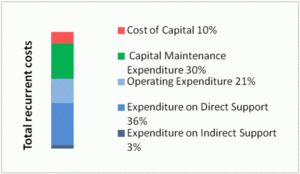Planning and budgeting for recurrent annual expenditure is a key challenge for sustainable service delivery. To assist with the analysis of recurrent costs to keep a system running, the life-cycle cost approach uses ‘building blocks’ to visualise and analyse these costs.
Published on: 22/12/2011
Planning and budgeting for recurrent annual expenditure is a key challenge for sustainable service delivery. After a water or sanitation system is built, it is often unclear what funds are required for operation and maintenance and eventual replacement of a system, the so called recurrent costs. To assist with the analysis of recurrent costs to keep a system running, the life-cycle cost approach uses ‘building blocks’ to visualise and analyse these costs. The building block method was presented for the first time during an international life-cycle cost seminar on 2 December 2011 in Kampala, Uganda (see seminars below).

The building blocks represent the total annual costs of operating any water or sanitation system. In this method, we separate the initial investment costs of a system from the recurrent costs. In the figure, the bar is made up of all the life-cycle costs components expect for one-off capital expenditure. The sum of these annualised costs (the height of the bar) is an estimate of the total annual costs for a system. It can also be used to represent either the actual (observed) expenditure or the ideal annualised funds required to keep systems running indefinitely (see ideal costs below).
This method is also used to visualise and compare expenditure across different systems and management models. For example, the proportions of the building blocks differ for different types of service providers. When a system is managed by a private utility, the cost of capital in the form of interest payments or return required on capital investment (including dividends) can be substantial. If a system is run by a NGO or a CBO the investment costs are often directly funded through national taxation or from international transfers (in the form of aid or soft loans). In this case, typically the cost of capital, i.e. the interest on a loan, is relatively low.
The life-cycle costs approach was introduced with a step-by-step methodology in Uganda. This seminar was attended by 45 participants representing international NGOs, civil society, the private sector, international banks and several African governments. If you would like to know more on the building blocks to analyse life-cycle costs, additional seminars will also be organised in English, French and Portuguese in 2012. Contact washcost@irc.nl for more information.
Ideal costs
In 2012, the WASHCost project is conducting action research on ideal recurrent cost allocations needed to deliver effective and sustainable services in different countries. Observed recurrent expenditure suggests that expenditure on the rehabilitation of systems (capital maintenance) and support to service providers (direct support) is insufficient to ensure sustainability of systems. Estimating ideal annual expenditure is the first step towards budgeting and planning for ongoing service delivery.
Additional reading
For more information on the life-cycle costs approach please download the briefing note below.
Jeske Verhoeven and Nicolas Dickinson, 22 December 2011